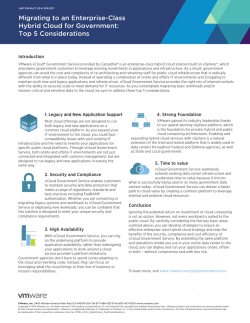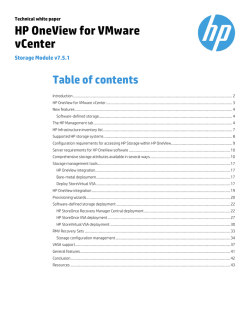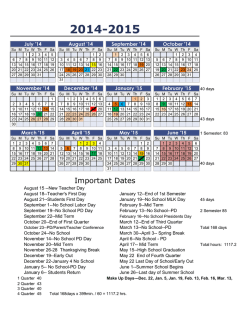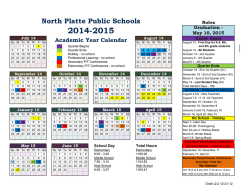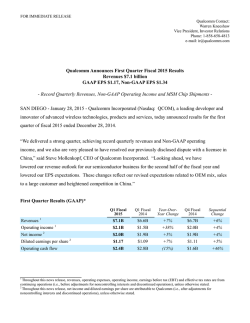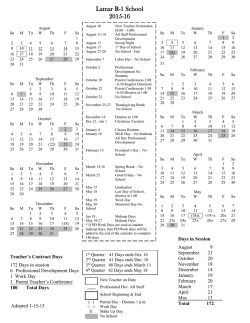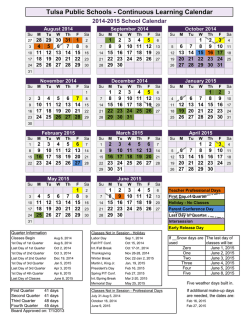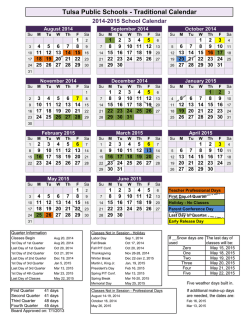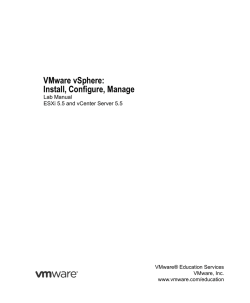
VMware Reports Fourth Quarter and Full Year
VMware Reports Fourth Quarter and Full Year 2014 Results Annual revenue growth of 16% to a record $6.04 billion Fourth quarter year-over-year revenue growth of 15% to a record $1.70 billion; up 16% on a constant currency basis New products and services including AirWatch, Cloud Management, NSX, Hybrid Cloud and Virtual SAN experiencing strong customer momentum VMware board of directors authorizes additional $1 billion share buyback PALO ALTO, Calif., January 27, 2015 — VMware, Inc. (NYSE: VMW), the global leader in virtualization and cloud infrastructure, today announced financial results for the fourth quarter and full year of 2014: Quarterly Review • Total revenues for the fourth quarter were $1.70 billion, an increase of 15% from the fourth quarter of 2013, or up 16% year over year in constant currency. • License revenues for the fourth quarter were $777 million, an increase of 13% from the fourth quarter of 2013, or up 16% year over year in constant currency. • Operating income for the fourth quarter was $344 million, a decrease of 8% from the fourth quarter of 2013. Non-GAAP operating income for the fourth quarter was $567 million, an increase of 7% from the fourth quarter of 2013. • Net income for the fourth quarter was $326 million, or $0.75 per diluted share, a decrease of 2% per diluted share compared to $335 million, or $0.77 per diluted share, for the fourth quarter of 2013. Non-GAAP net income for the quarter was $467 million, or $1.08 per diluted share, an increase of 7% per diluted share compared to $436 million, or $1.01 per diluted share, for the fourth quarter of 2013. Both GAAP and Non-GAAP results on a year-over-year basis include the impact of the acquisition of AirWatch, completed in the first quarter of 2014. Annual Review • Revenues for 2014 were $6.04 billion, an increase of 16% from 2013. • Operating income for 2014 was $1.03 billion, a decrease of 6% from 2013. Non-GAAP operating income for 2014 was $1.88 billion, an increase of 6% from 2013. • Net income for 2014 was $886 million, or $2.04 per diluted share, a decrease of 13% compared to $1.01 billion, or $2.34 per diluted share, for 2013. Non-GAAP net income for 2014 was $1.54 billion, or $3.56 per diluted share, an increase of 5% per diluted share compared to $1.46 billion, or $3.37 per diluted share, for 2013. Both GAAP and NonGAAP results on a year-over-year basis include the impact of the acquisition of AirWatch, completed in the first quarter of 2014. • Operating cash flows for 2014 were $2.18 billion, a decrease of 14% from 2013, and free cash flows for the year were $1.83 billion, a decrease of 17% from 2013. • Cash, cash equivalents and short-term investments were $7.08 billion and unearned revenues were $4.83 billion as of December 31, 2014. VMware also announced that its Board of Directors has authorized the purchase of up to $1 billion of its Class A common stock through the end of 2017. Stock will be purchased from time to time, in the open market or through private transactions, subject to market conditions. VMware now expects the stock repurchase program to more than offset dilution from its equity compensation programs in 2015. The new stock repurchase authorization is in addition to VMware’s ongoing $1 billion stock repurchase program, originally announced August 6, 2014. “Customers continue to partner with VMware because we offer a new model for IT designed to rapidly and automatically deliver any app, anywhere, without sacrificing the need for security, availability and compliance,” said Pat Gelsinger, chief executive officer, VMware. “In 2014, we surpassed the 6 billion dollar revenue mark for the first time, and in 2015 we’re looking forward to providing our customers with extraordinary value through the strongest portfolio of products, services and solutions in our history.” “We are very pleased with our Q4 revenue growth of 16% on a constant currency basis and with our 2014 results, which met or exceeded our revenue and operating margin guidance for the quarter and the year,” said Jonathan Chadwick, chief finance officer and chief operating officer, VMware. “Our portfolio of new disruptive products and services is experiencing significant customer momentum and driving strong growth into 2015. We are pleased to announce an additional $1 billion stock buyback, which reflects the opportunity we see ahead for VMware.” Recent Highlights & Strategic Announcements • AirWatch by VMware recently hit a landmark 15,000 customers globally, nearly double its closest competitor, and AirWatch Enterprise Mobility Management was named a “Leader” or equivalent in key industry analyst reports this year. • Continuing its strong momentum, VMware now has more than 400 customers for VMware NSX, the network virtualization and security platform for the software-defined data center. • With VMware-operated data centers across parts of North America, Europe and Asia, VMware announced further global expansion in Australia. In addition, on January 20, VMware announced new additions to VMware vCloud Air, including new disaster recovery capabilities, new advanced networking capabilities, and General Availability of vCloud Air Virtual Private Cloud OnDemand. • In the past quarter, VMware announced three additional qualified EVO:RAIL partners, NetApp, HP and Hitachi Data Systems, bringing the total EVO:RAIL partners to nine. • VMware announced general availability of new vRealize Cloud Management solutions, including a significant update to VMware vRealize™ Suite 6, a cloud management platform built for the hybrid cloud. These solutions simplify and automate how IT is managed, helping customers on their journey to deliver IT as a Service. • Following VMworld 2014 and VMworld 2014 Europe, where VMware hosted a combined total of over 32,000 registered attendees, VMware hosted VMware vForum customer and partner conferences in six countries across the Asia-Pacific Region hosting 31,500 attendees. The company will host a conference call today at 2:00 p.m. PT/ 5:00 p.m. ET to review financial results and business outlook. A live web broadcast of the event will be available on the VMware investor relations website at http://ir.vmware.com. Slides will accompany the web broadcast. The replay of the webcast and slides will be available on the website for two months. In addition, eight quarters of historical data for revenues and unearned revenues, excluding revenues generated each period by the products and services contributed to Pivotal Software, Inc. on April 1, 2013 and the products and services associated with the divestitures that occurred in 2013 will also be made available at http://ir.vmware.com in conjunction with the conference call. ### About VMware VMware is the leader in virtualization and cloud infrastructure solutions that enable businesses to thrive in the Cloud Era. Customers rely on VMware to help them transform the way they build, deliver and consume Information Technology resources in a manner that is evolutionary and based on their specific needs. With 2014 revenues of $6.0 billion, VMware has more than 500,000 customers. The company is headquartered in Silicon Valley with offices throughout the world and can be found online at www.vmware.com. Additional Information VMware’s website is located at www.vmware.com, and its investor relations website is located at http://ir.vmware.com. VMware’s goal is to maintain the investor relations website as a portal through which investors can easily find or navigate to pertinent information about VMware, all of which is made available free of charge. The additional information includes materials that VMware files with the SEC; announcements of investor conferences and events at which its executives talk about its products, services and competitive strategies; webcasts of its quarterly earnings calls, investor conferences and events (archives of which are also available for a limited time); additional information on its financial metrics, including reconciliations of non-GAAP financial measures to the most directly comparable GAAP measures; press releases on quarterly earnings, product and service announcements, legal developments and international news; corporate governance information; and other news, blogs and announcements that VMware may post from time to time that investors may find useful or interesting. VMware, VMworld, AirWatch, AirWatch by VMware, Virtual Private Cloud OnDemand, EVO: RAIL, vCloud Air, vRealize and NSX are registered trademarks or trademarks of VMware or its subsidiaries in the United States and other jurisdictions. All other marks and names mentioned herein may be trademarks of their respective organizations. Use of Non-GAAP Financial Measures Reconciliations of non-GAAP financial measures to VMware’s financial results as determined in accordance with GAAP are included at the end of this press release following the accompanying financial data. For a description of these non-GAAP financial measures, including the reasons management uses each measure, please see the section of the tables titled “About Non-GAAP Financial Measures.” Forward-Looking Statements This press release contains forward-looking statements including, among other things, statements regarding new products and services experiencing strong customer momentum; the value of shares repurchased under VMware’s stock repurchase program, the duration of such program and the expectation that the program will more than offset dilution from its equity compensation programs in 2015; momentum of disruptive products and services driving strong growth; the expansion of vCloud Air in Australia; and newly announced VMware products and services, such as new additions to vCloud Air, vCloud Air Virtual Private Cloud OnDemand, vRealize Cloud Management and updates to vRealize Suite 6. These forward-looking statements are subject to the safe harbor provisions created by the Private Securities Litigation Reform Act of 1995. Actual results could differ materially from those projected in the forward-looking statements as a result of certain risk factors, including but not limited to: (i) adverse changes in general economic or market conditions; (ii) delays or reductions in consumer, government and information technology spending; (iii) competitive factors, including but not limited to pricing pressures, industry consolidation, entry of new competitors into the virtualization software and cloud, end user and mobile computing industries, and new product and marketing initiatives by VMware’s competitors; (iv) VMware’s customers’ ability to transition to new products and computing strategies such as cloud computing, desktop virtualization and the software defined data center; (v) factors that affect timing of license revenue recognition such as product announcements and promotions and beta programs; (vi) the uncertainty of customer acceptance of emerging technology; (vii) changes in the willingness of customers to enter into longer term licensing and support arrangements; (viii) rapid technological changes in the virtualization software and cloud, end user and mobile computing industries; (ix) changes to product and service development timelines; (x) VMware’s relationship with EMC Corporation and EMC’s ability to control matters requiring stockholder approval, including the election of VMware’s board members; (xi) VMware’s ability to protect its proprietary technology; (xii) VMware’s ability to attract and retain highly qualified employees; (xiii) the successful integration of acquired companies and assets into VMware; (xiv) fluctuating currency exchange rates; (xv) fluctuations and volatility in VMware’s stock price; (xvi) changes in VMware’s financial condition; (xvii) changes in business opportunities and priorities that could cause VMware to consider alternative uses of cash; (xviii) fluctuations in the level of cash held in the United States that is available for stock repurchases; and (xix) changes in the dilutive impact in 2015 of shares issuable through VMware’s equity compensation programs. These forward-looking statements are based on current expectations and are subject to uncertainties and changes in condition, significance, value and effect as well as other risks detailed in documents filed with the Securities and Exchange Commission, including VMware’s most recent reports on Form 10-K and Form 10-Q and current reports on Form 8-K that VMware may file from time to time, which could cause actual results to vary from expectations. VMware assumes no obligation to, and does not currently intend to, update any such forward-looking statements after the date of this release. Contacts: Paul Ziots VMware Investor Relations [email protected] 650-427-3267 Joan Stone VMware Global Communications [email protected] About Non-GAAP Financial Measures To provide investors and others with additional information regarding VMware’s results, VMware has disclosed in this earnings release the following non-GAAP financial measures: non-GAAP operating income, non-GAAP operating margin, non-GAAP other income (expense), net, non-GAAP net income, non-GAAP income per diluted share, and free cash flows. VMware has provided a reconciliation of each non-GAAP financial measure used in this earnings release to the most directly comparable GAAP financial measure. These non-GAAP financial measures, other than free cash flows, differ from GAAP in that they exclude stock-based compensation, employer payroll tax on employee stock transactions, amortization of acquired intangible assets, realignment charges, acquisition and other-related items, certain litigation and other contingencies, the net effect of the amortization and capitalization of software development costs and gain on disposition of certain lines of business and other net, each as discussed below. Free cash flows differ from GAAP cash flows from operating activities in its treatment of capital expenditures. VMware has also presented in this earnings release quarterly and annual historical data for revenue and unearned revenue, excluding revenue generated each period by the products and services contributed to Pivotal Software, Inc. on April 1, 2013 and the products and services associated with the divestures consummated by VMware in 2013. VMware’s management believes that these measures are useful to investors because they allow investors to make meaningful comparisons of VMware revenues and unearned revenues across periods. VMware’s management uses these non-GAAP financial measures to understand and compare operating results across accounting periods, for internal budgeting and forecasting purposes, for short- and long-term operating plans, to calculate bonus payments and to evaluate VMware’s financial performance, the performance of its individual functional groups and the ability of operations to generate cash. Management believes these non-GAAP financial measures reflect VMware’s ongoing business in a manner that allows for meaningful period-to-period comparisons and analysis of trends in VMware’s business, as they exclude expenses and gains that are not reflective of ongoing operating results. Management also believes that these non-GAAP financial measures provide useful information to investors and others in understanding and evaluating VMware’s operating results and future prospects in the same manner as management and in comparing financial results across accounting periods and to those of peer companies. Additionally, management believes information regarding free cash flows provides investors and others with an important perspective on the cash available to make strategic acquisitions and investments, to repurchase shares, to fund ongoing operations and to fund other capital expenditures. Management believes these non-GAAP financial measures are useful to investors and others in assessing VMware’s operating performance due to the following factors: • Stock-based compensation. Stock-based compensation is generally fixed at the time the stockbased instrument is granted and amortized over a period of several years. Although stock-based compensation is an important aspect of the compensation of our employees and executives, the expense for the fair value of the stock-based instruments VMware utilizes may bear little resemblance to the actual value realized upon the vesting or future exercise of the related stock- based awards. Furthermore, unlike cash compensation, the value of stock options is determined using a complex formula that incorporates factors, such as market volatility, that are beyond VMware’s control. Additionally, in order to establish the amount of expense to recognize for performance-based stock awards, which are also an element of ongoing stock-based compensation, VMware is required to apply judgment to estimate the probability of the extent to which performance objectives will be achieved. Management believes it is useful to exclude stockbased compensation in order to better understand the long-term performance of VMware’s core business and to facilitate comparison of its results to those of peer companies. • Employer payroll tax on employee stock transactions. The amount of employer payroll taxes on stock-based compensation is dependent on VMware’s stock price and other factors that are beyond our control and do not correlate to the operation of the business. • Amortization of acquired intangible assets. A portion of the purchase price of VMware’s acquisitions is generally allocated to intangible assets, such as intellectual property, and is subject to amortization. However, VMware does not acquire businesses on a predictable cycle. Additionally, the amount of an acquisition’s purchase price allocated to intangible assets and the term of its related amortization can vary significantly and are unique to each acquisition. Therefore, VMware believes that the presentation of non-GAAP financial measures that adjust for the amortization of intangible assets provides investors and others with a consistent basis for comparison across accounting periods. • Realignment charges. Realignment charges include workforce reductions, asset impairments and losses on asset disposals, and costs to exit facilities. VMware’s management believes it is useful to exclude these items, when significant, as they are not reflective of VMware’s ongoing business and operating results. • Acquisition and other-related items. Acquisition and other-related items include direct costs of acquisitions and dispositions, such as transaction and advisory fees. Also included are accruals for the portion of merger consideration payable in installments that may be paid in cash or VMware stock, at the option of VMware. These accruals are primarily composed of amounts VMware has committed to make to designated founders and key executives of AirWatch, subject to employment conditions and indemnification claims, if any. Additionally, charges recognized for non-recoverable strategic investments or gains recognized on the disposition of strategic investments during 2014 are included as other-related items. As VMware does not acquire or dispose of businesses on a predictable cycle and the terms of each transaction can vary significantly and are unique to each transaction, VMware believes it is useful to exclude these items when looking for a consistent basis for comparison across accounting periods. • Certain litigation and other contingencies. VMware, from time to time may incur charges or benefits that are outside of the ordinary course of our business related to litigation and other contingencies. VMware believes it is useful to exclude such charges or benefits because we do not consider such amounts to be part of the ongoing operation of our business and because of the singular nature of the claims underlying the matter. • Capitalized software development costs. Capitalized software development costs encompass capitalization of development costs and the subsequent amortization of the capitalized costs over the useful life of the product. Amortization and capitalization of software development costs can vary significantly depending upon the timing of products reaching technological feasibility and being made generally available. VMware did not capitalize software development costs related to product offerings in either fiscal year 2014 or fiscal year 2013 given its current go-to-market strategy. In future periods, VMware does not expect amortization expense as previously capitalized software development costs have become fully amortized. • Gain on disposition of certain lines of business and other, net. In 2013, VMware recognized a gain as a result of exiting certain lines of business under its business realignment plan, which was partially offset by a charge recognized for a non–recoverable strategic investment. These transactions resulted in a net gain of $31 million. To the extent that significant gains or losses are realized on such dispositions and strategic investments, they do not occur on a predictable cycle, and such gains and losses are not reflective of VMware’s ongoing business and operating results. • Tax adjustment. Non-GAAP financial information for the quarter is adjusted for a tax rate equal to our annual estimated tax rate on non-GAAP income. This rate is based on VMware’s estimated annual GAAP income tax rate forecast, adjusted to account for items excluded from GAAP income in calculating VMware’s non-GAAP income. VMware’s estimated tax rate on non-GAAP income is determined annually and may be adjusted during the year to take into account events or trends that VMware management believes materially impact the estimated annual rate including, but not limited to, significant changes resulting from tax legislation, material changes in the geographic mix of revenues and expenses and other significant events. Due to the differences in the tax treatment of items excluded from non-GAAP earnings, as well as the methodology applied to VMware’s estimated annual tax rates as described above, the estimated tax rate on non-GAAP income may differ from the GAAP tax rate and from VMware’s actual tax liabilities. Additionally, VMware’s management believes that the non-GAAP financial measure free cash flows is meaningful to investors because management reviews cash flows generated from operations after taking into consideration capital expenditures due to the fact that these expenditures are considered to be a necessary component of ongoing operations. The use of non-GAAP financial measures has certain limitations because they do not reflect all items of income and expense that affect VMware’s operations. Specifically, in the case of stock-based compensation, if VMware did not pay out a portion of its compensation in the form of stock-based compensation and related employer payroll taxes, the cash salary expense included in operating expenses would be higher, which would affect VMware’s cash position. VMware compensates for these limitations by reconciling the non-GAAP financial measures to the most comparable GAAP financial measures. These non-GAAP financial measures should be considered in addition to, not as a substitute for or in isolation from, measures prepared in accordance with GAAP and should not be considered measures of VMware’s liquidity. Further, these non-GAAP measures may differ from the non-GAAP information used by other companies, including peer companies, and therefore comparability may be limited. Management encourages investors and others to review VMware’s financial information in its entirety and not rely on a single financial measure. Revenue Growth in Constant Currency We invoice and collect in the Euro, the British Pound, the Japanese Yen, the Australian Dollar and the Chinese Renminbi in their respective regions. As a result, our total revenues are affected by changes in the U.S. Dollar against these currencies. In order to provide a comparable framework for assessing how our business performed excluding the effect of foreign currency fluctuations, management analyzes year-over-year revenue growth on a constant currency basis. Since all of our entities operate with the U.S. Dollar as their functional currency, unearned revenues for orders booked in currencies other than U.S. Dollars are converted into U.S. Dollars at the exchange rate in effect for the month in which each order is booked. During 2014, we calculated constant currency on license revenues recognized during the current period that were originally booked in currencies other than U.S. Dollars by comparing the exchange rates used to recognize revenue in the current period against the exchange rates used to recognize revenue in the comparable period. We did not calculate constant currency on services revenues, which include software maintenance revenues and professional services revenues.
© Copyright 2026
